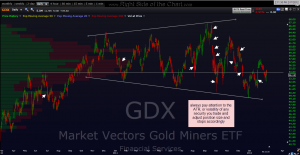originally posted February 17, 2012:
Beta-Adjusted Position Sizing is a term that I use for to process of determining how much trading capital to deploy to each of my trades. Beta is the term used in the financial markets to compare the price fluctuations of a security (stock, ETF, mutual fund, etc..) against it’s benchmark. The most common benchmark used is the S&P500 although a stock’s beta can be measured against any specific index or benchmark (e.g. comparing SPG (Simon Property Group, a large REIT, to the DJ REIT sector). However, for the purpose of determining my position size, I typically use the broad market (S&P 500 Index).
 Take GDX for example. Yesterday I had mentioned that fact that I completely disregard the big bullish engulfing candlestick put in on the daily chart since engulfing candlesticks are very common with the big price swings in GDX. If you click to expand this chart, you will notice that the day to day swings are much larger than the daily moves in the SPX. This gives GDX (forget about any correlations or lack thereof to the SPX for this purpose) a very high beta.
Take GDX for example. Yesterday I had mentioned that fact that I completely disregard the big bullish engulfing candlestick put in on the daily chart since engulfing candlesticks are very common with the big price swings in GDX. If you click to expand this chart, you will notice that the day to day swings are much larger than the daily moves in the SPX. This gives GDX (forget about any correlations or lack thereof to the SPX for this purpose) a very high beta.
Another tool to use is the Average True Range (ATR) indicator on your charts but honestly, you should just be able to eyeball a chart and see how volatile any stock or ETF has traded in the past. Most importantly, if you are looking at a stock in a pattern like a bullish falling wedge, you must realize that prices continue to be compressed as the wedge forms so don’t assume that lower volatility will continue going forward. On the contrary, falling wedge patterns are like coiled springs and once they trigger (break-out) then volatility often increases very sharply, very fast.
I don’t use any hard formula when determining my position size, maybe because I’ve been trading and investing for so many years that it becomes an automatic, especially as I often trade many of the same stocks repeatedly over time. However, as a rookie trader or investor, I believe that it is critical to your success that you adjust your position size according to both the potential risk AND return (which ALWAYS go hand in hand).
For example, one of my recent trades was the CVM long set-up that was posted on Jan 12th (2012) while just breaking out of a nice falling channel. CVM was a .34c stock back then which rule #1, DON’T USE FULL POSITION SIZES FOR PENNY STOCKS (sorry to yell, just wanted to make that clear). The top of my final target zone was at .48c, or about 41% higher. This trade hit that level just 3 days later (it actually stopped and reversed at .49c). However, if that trade didn’t work out and the breakout failed, I would not have been surprised to see it drop 10%+ in no time flat. Therefore, on a trade like that, being a low-priced stock with a volatile trading history, if you would normally put, say $10k into a SPY or GE trade, then you might only want to put $2500-$3k (maybe even less) into CVM. Think of it this way, if you are looking at a potential gain of 40% on the trade, then $3k x 40% = $1,200 profit. That is equivalent to a 12% gain on your $10k SPY trade (and when was the last time the SPY when up 12% in 3 days?)
Also make sure to beta-adjust your ETF trades, accounting not only for any leverage (2x or 3x long or short ETF’s) but also the sector. That NUGT short that I have on right now is not only leveraged 3x against the gold miner sector but that sector itself is one of the most volatile sectors out there to boot. Therefore, I not only lower the position size that I take on the trade but I also widen my stops considerably to account for both the leverage as well as the inherent volatility in the sector. On a final note, it works the other way too. For example, if I were to trade the TLT (long-term US gov’t bond ETF), then I might use about 1 1/2 times my usually position size in order to account for the lower than usual expected gains and volatility.


Leave A Comment
You must be logged in to post a comment.